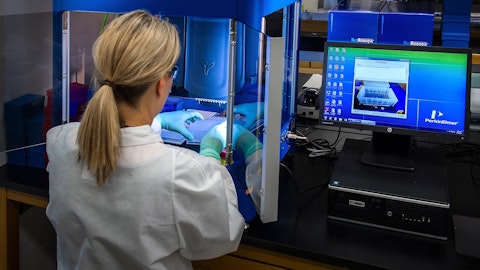Shubham Maheshwari: I think at this point, when it comes to the guide or the outlook around 3% to 5% down, I would say that at this point, we would be more closer to the lower end of the range than the higher end of the range, meaning more between 4% to 5% as opposed to 3% to 4%. So that is there because we were initially expecting a little bit better performance from our Industrial segment. I’m not sure if we really commented on Medical ex-China. China still continues to be a situation. China was a pretty strong growth area for us, but CT and some other products over there. And there — outside of the two things that we talked about, macroeconomic as well as anticorruption, we expect China to come back. It’s just that the timing is somewhat of an unknown factor for us.
And the full year will really, Larry, depend upon does China come back at the beginning of Q3? Or does it come back towards the end of Q3, and that will determine the Medical — overall Medical situation in a big way for us.
Lawrence Solow: Okay. And then just on the Industrial piece. Again, I know you don’t actually go by segment, but you had a great year last year. This quarter, like I said, was up 10%, but down somewhat sequentially. And now you’re lapping much more difficult comps, too, obviously, as we get even next quarter. Do you still — but it sounds like — it sounds a little bit mixed there, too. Do you still think — certainly, it sounds like you’ll grow sequentially or that you’re building that into expectations? Do you think you grow in the back half year-over-year? Or does that segment overall — you did 220 last year. Is that a good place to start for this year? Or do you think you can see that?
Shubham Maheshwari: Yeah. A little bit of — a few things going on there. Let me explain that, Larry. So, yes, the comps are going to become — Industrial, we grew very well last year. We grew 19% year-over-year in 2023. So that’s clearly a very strong growth we had last year in Industrial. And yes, you rightly pointed out we did $220 million there. In Industrial, we are seeing kind of like a tale of two cities. And why I say that is this. In industrial, it is still very strong in the cargo inspection area, where we are shipping a lot of hardware or what we call industrial systems or these big linear accelerators or LINACs. When we ship these LINACs, our gross margin on the hardware or the system upon shipment is lower. Our gross margin on the service piece is much higher.
So, overall, when you look at our Industrial, we have softness ex-cargo. And within cargo, the distribution between systems and service is a lot more skewed towards systems because right now we are shipping quite a bit of that. So that brings the overall gross margin down for the segment. It’s a good thing because it will generate…
Lawrence Solow: Right.
Shubham Maheshwari: Yeah. Exactly. So that’s happening on the Industrial side. In terms of overall volume or sales levels for Industrial, obviously, we would not be able to repeat the percentage growth factor in Industrial of 2023. But we are still hopeful of having a year-over-year growth in Industrial, again, provided the timing when it comes back. The cargo inspection business, we have good visibility for the rest of the year. On the non-cargo industrial business, we need to see how it develops. If it comes back sooner than later, then the overall year will be a growth year for sure. So that is something that we are monitoring, and that’s where we are.
Lawrence Solow: And just remind me, the cargo, that’s like it includes like security too, that’s like one-third of the segment, plus or minus. Is that about right? And then everything else is two-thirds. Am I — is that right? The ballpark?
Shubham Maheshwari: So security inspection is around in that range.
Sunny Sanyal: For cargo.
Shubham Maheshwari: Yeah. Sometimes it can go higher, Larry, in certain quarters when we’re shipping — right?
Lawrence Solow: Okay.
Shubham Maheshwari: Yeah.
Lawrence Solow: Okay. Just last question, just on the photon technology and some being adopted more or maybe not — it just sounds like we’re in the early stages of adoption. And you mentioned one particular OEM. I don’t know if you could answer, I guess, a broader question. With this, I guess, to some extent, cannibalize the existing technology? And is this customer a customer today of you guys in your existing technologies?
Shubham Maheshwari: Larry, before we go to this photon counting related question, I just want to correct that cargo is around 20% of the segment, not 30%.
Lawrence Solow: Okay.
Shubham Maheshwari: And with that — yeah. And then on the photon counting, I’ll ask Sunny to comment here. But in general — not in general, specifically what Sunny talked about was photon counting for CT. So that is not a market that we are participating today. So, there is no cannibalization. That’s really new market, new business development for us.
Sunny Sanyal: Yeah. And Larry and everyone, in general, the photon counting detectors go into a whole new type of applications, where someone needs a flat panel or a large area detector, they will go with a flat panel detector and where they need a different type of performance, particularly in high-speed imaging or a different type of dynamic imaging, they’ll use photon county detectors. So, we are not seeing cannibalization or we don’t expect cannibalization at this stage between flat panel detectors and photon counting. So that’s one thing. So within existing customers, these would be new applications, new products. And then, of course, as Sam said, the CT is a brand new space, new addressable market.
Lawrence Solow: Got it. I appreciate that clarification. Thank you, Sunny, and thank you guys.
Operator: Thank you. Our next question comes from the line of Michael Toomey with Jefferies. Please proceed with your question.



